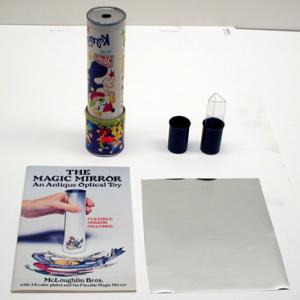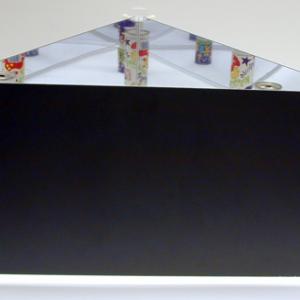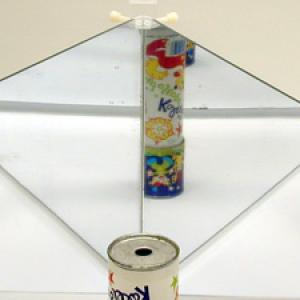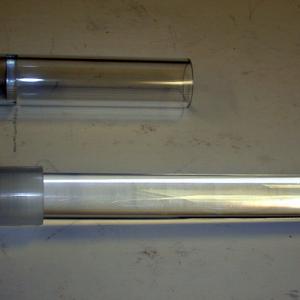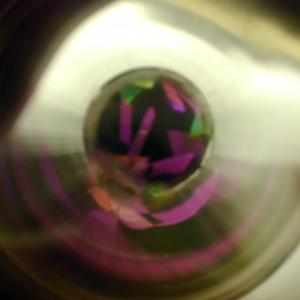College of Liberal Arts & Sciences
6A10.42 - Mirrors - Kaleidoscope - Teleidoscope -Polariscope
Using the special corner mounting assemble the large demonstration kaleidoscope. Place an object in the center of the kaleidoscope and look into the kaleidoscope at a shallow angle to see multiple images. Or, lower the kaleidoscope over your head and look at multiple images of yourself.
- Thomas B. Greenslade Jr., "Kaleidoscopes Made With Big Mirrors", TPT, Vol. 47, # 6, Sept. 2009, p. 334.
- Christopher Chiaverina, Cindee Scott, and Patricia Steele, "The Connections Project: Art, Physics, and Mathematics", TPT, Vol. 35, # 5, May 1997, p. 292.
- Terrence P. Toepker, "The 70-mm Kaleidoscope", TPT, Vol. 33, # 8, p. 536-537, Nov. 1995.
- Joe Pizzo, "Shadow Kaleidoscope", TPT, Vol. 24, # 4, p. 237, April 1986.
- Jearl Walker, "Shadow Kaleidoscope", TPT, Vol. 24, # 4, Apr. 1986, p. 237.
- Laurence A. Marschall, Emma Beth Maschall, "Reflection in a Polished Tube", TPT, Vol. 21, # 2, Feb. 1983, p. 105.
- "Erratta", TPT, Vol. 21, # 6, Sept. 1983, p. 409.
- D. K. Cohen and J. E. Potts, "Light Transmission Through Reflecting Cylindrical Tubes", AJP, Vol. 46, # 7, July 1978, p. 727.
- O-135: "Kaleidoscope with 3 Slides", DICK and RAE Physics Demo Notebook.
- O-1c: Wallace A. Hilton, Physics Demonstration Experiments.
- George M. Hopkins, "Multiple Reflection", Experimental Science, p. 212.
- A. D. Bulman, "A Kaleidoscope", Model-Making for Physics, p. 41.
- John Henry Pepper, Henry George Hine, The Boy's Playbook of Science, p. 296.
- Jearl Walker, "An Inexpensive Homemade Polarimeter Can Analyze Optically Active Compounds", The Amateur Scientist, Jan., 1986.
- Jearl Walker, "The Kaleidoscope Now Comes Equipped with Flashing Diodes and Focusing Lenses", The Amateur Scientist, December, 1985.
- Jearl Walker, "Moire' Effects, the Kaleidoscope and Other Victorian Diversions", The Amateur Scientist, December, 1978.
- John Henry Pepper, "The Kaleidoscope", Cyclopadic Science Simplified, p. 31.
- Carson I. A. Ritchie, "Kaleidoscope", Making Scientific Toys, p. 29.
- Jodi and Roy McCullough, "Reflection with a Kaleidoscope", The Role of Toys in Teaching Physics, p. 4.154.
- Martin Gardner, "58, Make A Kaleidoscope", Smart Science Tricks, p. 89.
- Jearl Walker, "6.65, Kaleidoscopes", The Flying Circus of Physics Ed. 2, p. 266.
- Ed Sobey, Woody Sobey, "Kaleidoscope", The Way Toys Work, p. 73.
- 5.15: Jearl Walker, "Number of Images in Two Mirrors", The Flying Circus of Physics with Answers.
- 114: "Make it: Taleidoscope/Kaleidoscope", The Ben Franklin Book of Easy & Incredible Experiments," A Franklin Institute Science Museum Book.
- "Duck Into Kaleidoscope", Exploratorium Science Snackbook, pp. 44.1 - 44.2.
- Raymond Bruman, "Shadow Kaleidoscope", Exploratorium Cookbook I, pp. 20.1 - 20.2.
- T. D. Rossing, C. J. Chiaverina, "3.5, Kaleidoscopes", Light Science, Physics and Visual Arts, p. 62.
- T. D. Rossing, C. J. Chiaverina, "# 6, Constructing a Simple Kaleidoscope, Experiments for Home, Laboratory, and Classroom Demonstration", Light Science, Physics and Visual Arts, p. 76.
- T. D. Rossing, C. J. Chiaverina, "Experiment 3.2, Contrast A Kaleidoscope", Light Science, Physics and Visual Arts, p. 382.
- Simon Quellen Field, "The Polariscope", Gonzo Gizmos, p. 220 - 227.
- Bobby Mercer, "Kaleidofoilscope", Junk Drawer Physics, p. 118.
- Prof. Robert Griffith, "A Novel Kaleidoscope", Boys' Useful Pastimes, p. 90.
- Dr. Gordon Stables, R.N., C. Stansfeld Hicks, J. N. Maskelyne, Rev. Harry Jones, M.A, Dr. Stradling, Captain Crawley, Rev. A. n. Malan, M.A., F.G.S., and Many Others, "Chapter XL - The Kaleidoscope, and How to Make It", The Boy's Own Book of Indoor Games and Recreations, A Popular Encyclopaedia for Boys, p. 385.
- The Queen Catalogues Vol. I, Catalogue of Microspces and Accessories, No. 1743, p. 3.
Disclaimer: These demonstrations are provided only for illustrative use by persons affiliated with The University of Iowa and only under the direction of a trained instructor or physicist. The University of Iowa is not responsible for demonstrations performed by those using their own equipment or who choose to use this reference material for their own purpose. The demonstrations included here are within the public domain and can be found in materials contained in libraries, bookstores, and through electronic sources. Performing all or any portion of any of these demonstrations, with or without revisions not depicted here entails inherent risks. These risks include, without limitation, bodily injury (and possibly death), including risks to health that may be temporary or permanent and that may exacerbate a pre-existing medical condition; and property loss or damage. Anyone performing any part of these demonstrations, even with revisions, knowingly and voluntarily assumes all risks associated with them.
